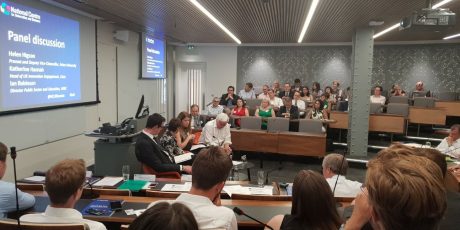
How IDEALondon became a case study for a new kind of collaboration
Last week the National Centre for Universities and Business released its ‘State of the Relationship 2018’ report, and I was delighted to see Cisco featured for our work with IDEALondon.
The report is all about shining a light on the partnerships between business, education, government and other organisations in the UK.
There are some promising findings, such as the number of interactions between universities and business is increasing. UK universities have also seen an increase in licences and growth in income and patents within UK.
But we’re not there yet – R&D is just 1.7% of GDP and 75% of this investment comes from just 400 companies.
This is why I was so excited to be invited to speak at the launch event for the report, joining a panel with HSBC’s Ian Robinson and Aston University’s Helen Higson.
I was there to talk about how strong relationships between business, academia and government have driven everything we’ve achieved at IDEALondon. And seeing as I’ve been in the centre since the day we opened, I’m always happy to talk about it!
A blueprint for business and university collaboration
I strongly suggest reading the full report if you’re interested in collaboration and co-innovation, but with 100-or-so case studies to get through I’ll stick with Cisco’s entry for now.
Our case study made it into the report because we’ve demonstrated the power of collaboration between two commercial organisations (Cisco and EDF Energy) and a top university (UCL), resulting in 700 new jobs and more than £80million investment.
But while the case study covers what we’ve achieved so far, I’m even more excited about where we’re going.
IDEALondon has been the perfect blueprint for collaboration between business and academia, and since its launch we’ve scaled the model into multiple locations across the world, including our Mi-IDEA centre up in Manchester and our newest centre in Istanbul.
It hasn’t always been an easy ride, of course. One of the biggest challenges when corporates partner with academic institutions is the speed at which you can get things done.
Large corporates work from quarter to quarter while universities tend to focus on much longer-term research projects. The key to our success has been our ability to meet in the middle and make it work.
While I’m talking about the report I should probably give a shout out to my fellow panellists, Ian and Helen.
Ian was there to talk about how HSBC has been working closely with universities and other stakeholders in preparation for the opening of its new banking headquarters in Birmingham, while Helen was there to discuss the changing dynamic between educational providers, learners and employers.
Both provided great examples of the power of strong relationships between different people and organisations in achieving innovation.
Mutual gains
It was a pleasure to speak at the State of the Relationship event and to be included in the report in the first place.
What really struck me about the night is how excited academics are about working with corporates – I must have had 10 or more universities approach me following my panel session to ask about working with Cisco.
To me this proves something I’ve believed ever since I started working at IDEALondon: business needs academia and vice versa, and we can achieve so much more when we work together.
Read the full report to learn more
Tags:


